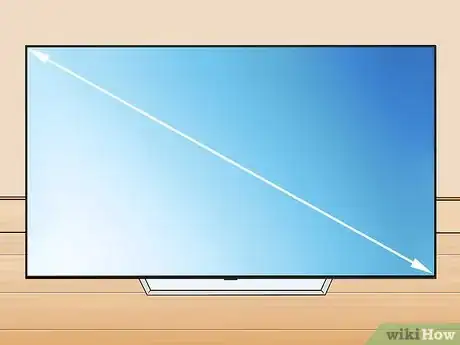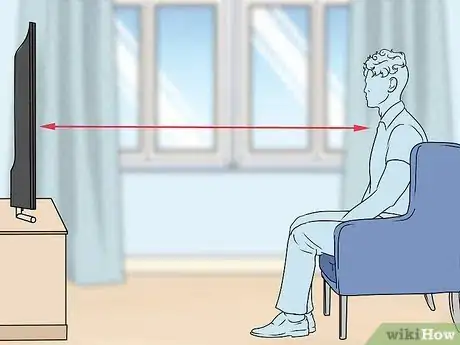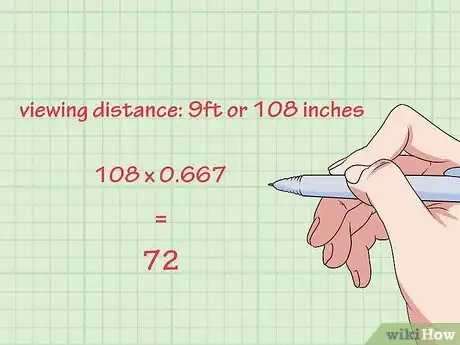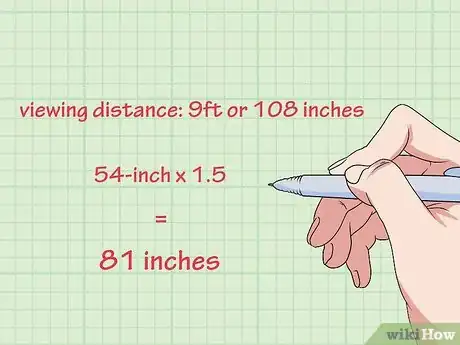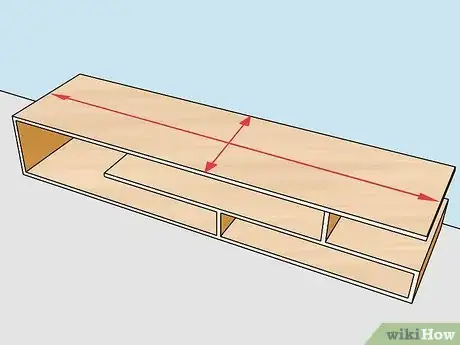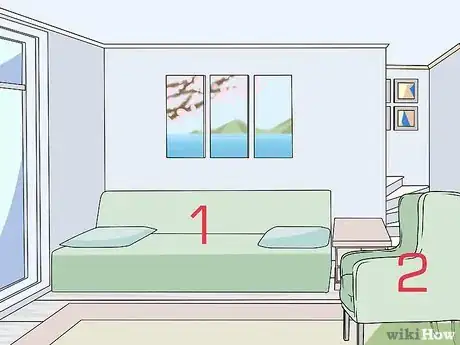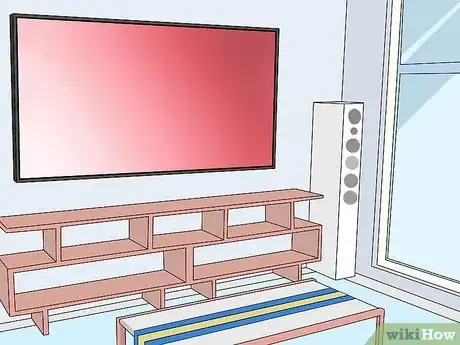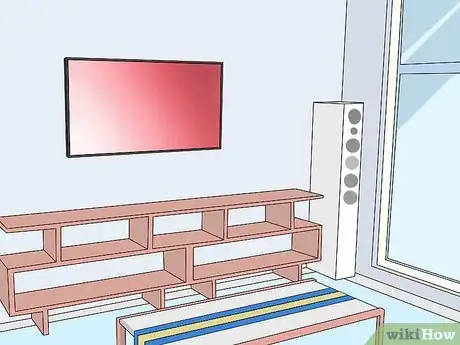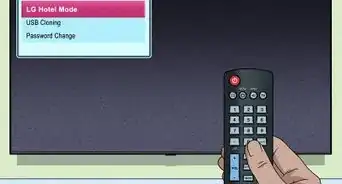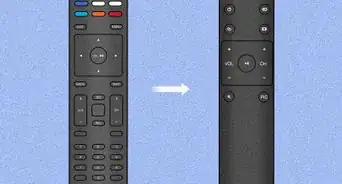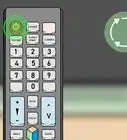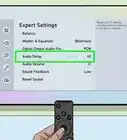This article was co-authored by wikiHow Staff. Our trained team of editors and researchers validate articles for accuracy and comprehensiveness. wikiHow's Content Management Team carefully monitors the work from our editorial staff to ensure that each article is backed by trusted research and meets our high quality standards.
There are 8 references cited in this article, which can be found at the bottom of the page.
This article has been viewed 34,700 times.
Learn more...
When deciding on a TV size, it is important to also consider other factors like screen resolution and the overall size and layout of your room. This wikiHow article will teach you how to identify TV features and take measurements that help you pick the perfect TV size.
Steps
Selecting TV Features
-
1Select a screen size by taking a diagonal measurement of the TV. TVs are measured from corner to corner, so keep that in mind when you’re browsing. That 40 in (100 cm) floor model you have your eye on isn’t as big as you might think. For that reason, a lot of buyers get their TV home only to realize it looks smaller than they expected. Compare the diagonal size to the amount of space you have available in your home.[1]
- For example, a 40 in (100 cm) set is approximately 20 in (51 cm) tall and 35 in (89 cm) wide.[2]
-
2Choose a higher resolution if you plan on sitting close to the TV. A higher resolution means you can get closer to the TV before you notice pixels on the screen. Pixels are the mini dots of light that make up the whole picture on your TV. If you plan on putting a TV in an enclosed room, a smaller one offers a better picture since the pixels will be harder to detect.[3]
- The standard resolution for TVs as of 2019 is 1080p. This resolution is perfectly fine for most situations.
- A lot of higher-end TVs come with 4K resolution, which makes pixels harder to detect when you’re up close. However, this only works with content made for 4K resolution.
- Another option is 720p resolution. It is mostly used in smaller budget TVs since the pixels are much easier to spot.
Advertisement -
3Factor in the price you’re paying for the TV’s features. Budget for your new TV to figure out what size you can afford. TVs have become more affordable over time, so you can get a bigger screen at a better price than you could in the past. You’re still going to pay a little more for a bigger TV with a better resolution and more features. Check out different options before making a purchase.[4]
- For example, a 4K TV might cost twice as much as a 1080p TV of the same size. You don’t need to pay for the 4K resolution if you don’t have a use for it.
- There are many different TV brands out there. Manufacturers offer all sorts of different features they claim affects your viewing experience, so familiarize yourself with what’s available to get the best option for your situation.
Calculating the Optimal TV Size
-
1Measure the distance in inches from the mount to where you sit. This is called the viewing distance and it’s useful for estimating the best TV size for your room. Arrange your room first so you know where the TV will be and where you like sitting when watching it. Then, use a tape measure to calculate the distance. Write the number down on a spare piece of paper.[5]
- Most people sit about 9 ft (2.7 m) from the TV on average, but this could vary depending on your room size and layout.
-
2Estimate the maximum TV size possible by multiplying by 0.667. This will give you a basic size limit to narrow down your options while shopping. Any screen bigger than the maximum is likely to be too much to take in while watching. Move your seat back to make it less overwhelming. Keep in mind that the maximum size isn’t usually the best or most affordable option for your situation.[6]
- For example, if your viewing distance is 9 ft (2.7 m), or 108 inches, stick to a TV 72 inches in size or less. 108 x 0.667 = 72.
-
3Multiply a TV size by 2 to see if it is in your viewing range. Pick the TV size you want, do a simple calculation, then compare it to your room setup. Use this result to settle upon the right TV size for your room. This estimate isn’t perfect, so it can change depending on factors like your room layout and budget. Switch to the next closest size if you need to in order to improve your viewing experience.[7]
- For example, if your viewing distance is 9 ft (2.7 m), or 108 inches, start looking at 54-inch TVs. 54 x 2 = 108.
- Keep in mind that this estimate is very general. It’s a safe recommendation to follow, but it’s not always optimal.
-
4Decrease the required viewing distance to compensate for 4K TVs. These TVs have a better overall picture quality as long as you’re watching content made for 4K. You can sit closer to the screen without seeing the pixels. This is super helpful when you’re looking to get the best picture quality with limited room space. Multiply the TV size by 1 or 1.5 to figure out if it fits well in your home.[8]
- For instance, a 54-inch TV works best when placed 54 to 81 inches from where you sit. 54 x 1 = 54. 54 x 1.5 = 81.
- Remember that 4K TVs provide a more optimal viewing experience when you’re up close. You don’t have to enjoy your TV that way, but it’s worth considering. You could get a bigger TV if you’re going to sit further back.
-
5Measure the size and depth of any mounts or stands you plan on using. If you’re planning on using a wall mount or entertainment stand, set it up in advance, if possible. The support has to be big enough to hold whatever TV you buy. They also take up space, often cutting down the viewing distance from your favorite seat. A bulky support could limit your placement options as well.[9]
- Count on wall mounts moving your TV up to a 1 ft (0.30 m) from the wall. Some entertainment stands extend out further. You may need to opt for a smaller TV to compensate.
-
6Count the number of seats you plan on putting in front of the TV. The best seat in the house is the one directly in front of the screen. A bigger TV means you can gather a large group of people and still give everyone a good show. Reserve smaller TVs for individual or family use. Make sure you actually have space in front of the TV to fit all the people you plan on entertaining.[10]
- Save TVs 32 in (81 cm) in size or less for individual usage and tight budgets. These TVs are great for small apartments and dormitories. You could fit it on a countertop or desk.
- TVs up to about 43 in (110 cm) in size are perfect for the average viewer. You can get a decently-sized TV at a reasonable price and fit a family around it.
- Go for big screens if you’re entertaining a party or have money to spend. These jumbo-sized TVs take up a lot of space, but you get the full effect of seeing your favorite shows in high definition.
-
7Select a bigger TV screen to increase the viewing angle in your room. All TVs have a viewing angle, which is how far to the side you can stand while still seeing a clear picture. A conservative estimate for this is a 30-degree angle out from the edges of the screen. Test the angle by walking out from the stand, mount, or monitor. Anyone outside of this viewing angle won’t be able to see the screen.[11]
- Larger TVs have more width, meaning that you can fit more people within the viewing angle. With a smaller TV, you can’t walk as far to the side before you lose sight of the image on the screen.
- The viewing angle will depend on your room layout. You don’t need to worry as much about the viewing angle in a compact room. If your furniture is spread out more, the screen has to be bigger to compensate.
-
8Select a smaller TV if you want it to be inconspicuous. Big screen TVs are massive pieces of furniture. They take up a ton of space and are hard to miss when you walk into a room. Depending on how you decorate your room, this may not be what you want. A smaller set has less of a chance to dominate a room.[12]
- The aesthetic element of a TV is up to personal choice. If you’re dedicating a special room to be your personal viewing room, a big TV is probably fine. It can be overwhelming in an ordinary room.
- Consider the TV to be a piece of furniture and a decoration. Although bigger is generally better when it comes to TV size, it isn’t always true.
References
- ↑ https://www.rtings.com/tv/reviews/by-size/size-to-distance-relationship
- ↑ https://www.inchcalculator.com/169-tv-dimensions/
- ↑ https://www.rtings.com/tv/learn/what-is-the-resolution
- ↑ https://www.techradar.com/how-to/what-size-tv-do-i-need
- ↑ https://www.tomsguide.com/us/choose-right-tv-size,news-24708.html
- ↑ https://www.cnet.com/how-to/how-big-a-tv-should-i-buy/
- ↑ https://www.tomsguide.com/us/choose-right-tv-size,news-24708.html
- ↑ https://www.tomsguide.com/us/choose-right-tv-size,news-24708.html
- ↑ https://www.tomsguide.com/us/choose-right-tv-size,news-24708.html
- ↑ https://www.techradar.com/how-to/what-size-tv-do-i-need
- ↑ https://www.cnet.com/how-to/how-big-a-tv-should-i-buy/
- ↑ https://www.forbes.com/sites/larrymagid/2018/08/03/forget-the-formulas-and-pick-a-tv-size-thats-right-for-you/#73a469be37f4
- ↑ https://www.whathifi.com/advice/tv-buying-guide-how-to-choose-right-tv-you
